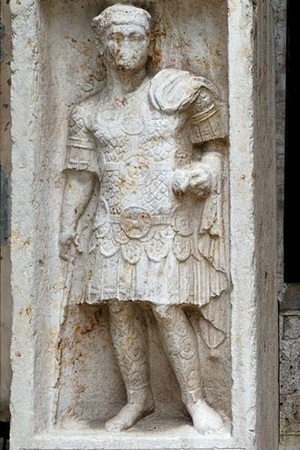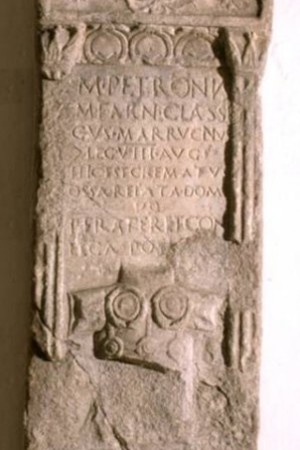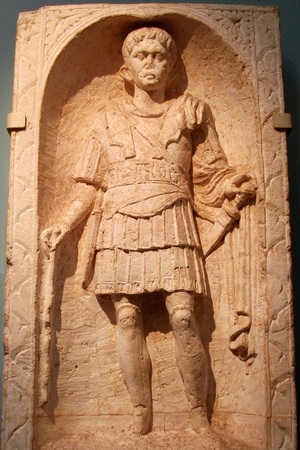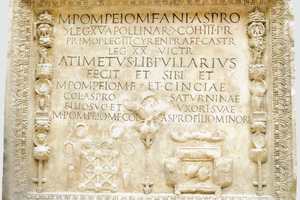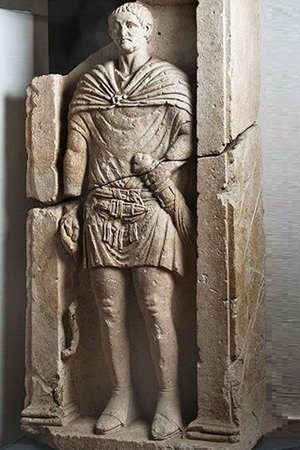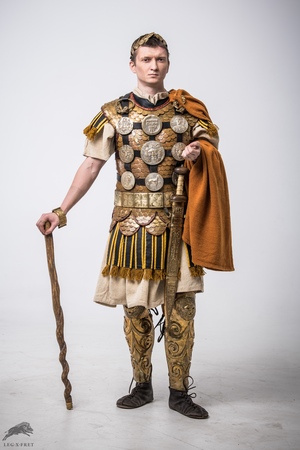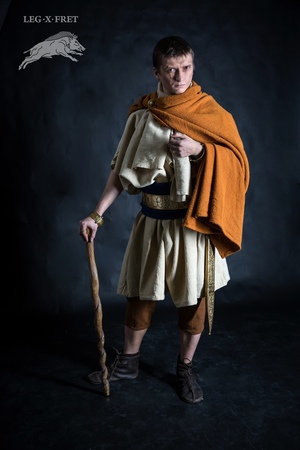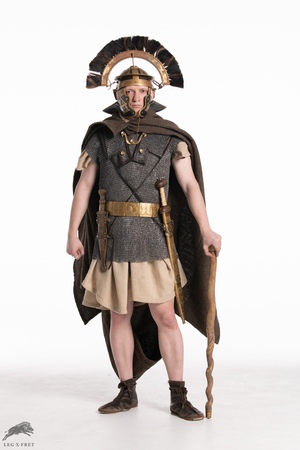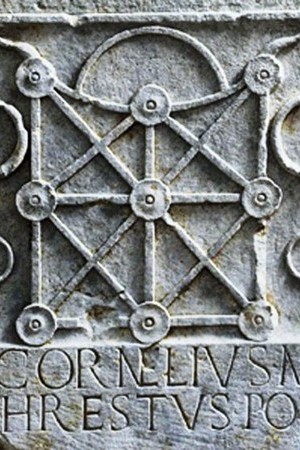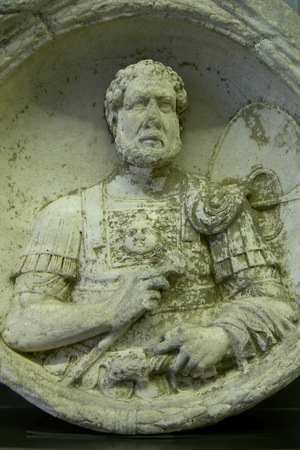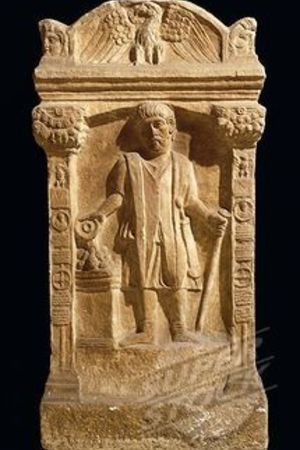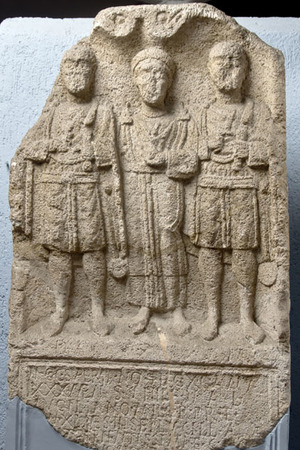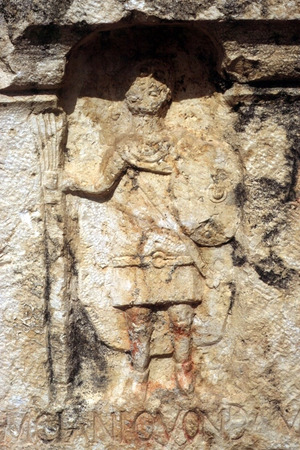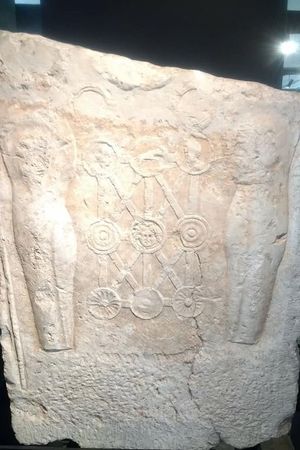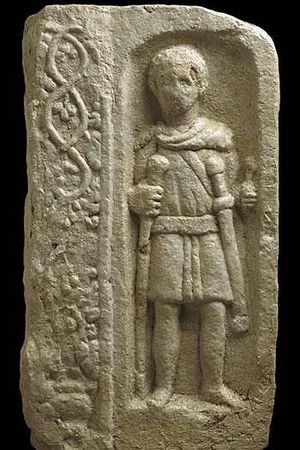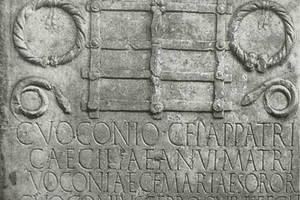Centurion
Centurion (lat. centurio – in charge of century) — was a military position in ancient Rome, he was a commanding officer of a century. There was an alternative way to pronounce the word “centurion”, instead its usual way it could’ve sounded like “kenˈtʃʊəriən”, especially if we are speaking about late period in a Greek manner (ancient Greek κεντυρίων, κεντυρίωνος - «centurion, centurionos»). Centurions with a higher rank were in charge of bigger units – maniple, double cohort, Vexillatio.
General information
Centurions’ career was about gradual rank advancing up to primipilus. Roman writer Vegetius wrote: “To advance to a primipilus it was necessary to one by one go through every position in cohorts in various departments”, so it was believed, that in order to acquire the highest centurion rank “primipilus” – it was necessary to go through 60 ranks. Nonetheless, the fact, that somebody would be interested in such a “promotion” from one cohort to another one, even with a greater number, is quite doubtful. The situation created difficulties within centurions’ job as well as difficulties concerning legionaries’ subordination. There is also an assumption, that initially centurions passed through the ranks of post-prior, and then prior positions. But even in a such case, centurion had to go through 60 ranks for 20 years, changing century every 4 months, which would negatively affect military fighting efficiency. So here is a conclusion in this regard – there is no consistent scheme of centurions’ promotions known to modern scientists and their career could have been different depending on the period or on the legion. The only known thing is that rank of primipilus was usually assigned to someone at the age of 40 to 50, after 10 to 20 years of serving as a centurion. It’s also should to be mentioned, that they could’ve transferred experienced centurions not only between cohorts but also between legions. Rarely, centurions from the legions could’ve also served in a praetorian cohort. Here is a remarkable example - M. Pompeio Aspro, centurion (later he became a prefect), who served in Legio XV Apollinares, Cohors III Praetoria, Legio III Cyrenaica, Legio XX Valeria Victrix.
Military commander assigned centurions on his own, most likely, out of men, who he knew best, the most experienced ones and the ones who were decent legionaries overall. As a rule, only citizens over 30 years could be a centurion. Assigned centurion appointed himself an assistant – optio (opcio). After Marius reform optiones like centurions were appointed as commanders more often. Centurions received payments several times (2-4) bigger than legionaries. If we compare them with a modern army, centurions can be matched with a squadron leader, while a primipilus can be matched with regiment leader, and was in charge of a whole cohort with extra capacity.
Centurions were a career officers, while legates and tribunes were assigned to their positions mostly because of political reasons (they were assigned to the positions through voting or by military commanders’ assignment from senatorial and equestrian classes). That’s why specifically centurions were in charge of organizing legion activities, military training etc.
We can observe such situation during Republic period, when legion didn’t have a permanent commander, and there were only formally assigned tribunes – young noble men, who usually didn’t have any battle experience or military knowledge, such a position was just an opportunity for them to start their political career.
Centurions often abused their power – even a simple protection from corporal punishment from a centurion could lead to even worse punishment – death penalty. Bribery was a common situation: centurions extorted money from legionaries for vocations, camp job immunities and in any other suitable situation.
Tacitus mentions a centurion nicknamed «Cedo Alteram» («Give me another one») – he received the nickname, because he frequently broke vitiuses on backs of messed up legionaries. Eventually he was murdered by legionaries during a military uprising.
Centurion requirements according to Vegetius: “To be a centurion a man has to be physically strong, tall, to be able neatly and powerfully throw spears and darts, to be a sword master or a shield master, to be good with weapons, to be vigilant, moderate, lively, ready to perform orders and not to discuss them, able to discipline tent mates, motivating to perform military exercises, caring about legionaries’ apparel and caring that legionaries’ weapons are cleaned and shiny.
In battle a centurion was in the first row, on the right side of his century. Centurions had the highest death rate among the whole roman army.
Centurions Hierarchy
There were 60 centurions in a legion on a regular basis. Initially, before manipular organization was introduced, centurion was in charge of phalanx, which was tactically meaningless. After reorganization in the end of 4 century BCE, two centurions lead a maniple – the first one (prior – “front”) was in charge of right flank, the second one (posterior – “back”) was in charge of left flank, more than that maniple consisted from two centuries. Right flank centurion was a senior one. Besides flank, seniority depended on their unit. Centurion from elite maniple of pilus (triarii) was senior to centurions from hastati or principes.
After The Marian reforms cohort became main battle unit. It was composed of 6 centuries, and a legion had 10 cohorts. Following the tradition third maniple of cohorts still called “pilus”, “principes” and “hastati”(but the only difference at the moment was their disposition, but they were similar in terms of equipment and origin). As a result, among the centurions formed a rigid hierarchy: the senior was the first centurion (prior) of pilus, who commanded the entire cohort, followed by the first centurion of the principles, then the Hastati, then the second centurions (posteriores) of pilus, the principles, and the hastati. There was also another hierarchy concerning cohort number. In such a way, the highest ranked centurion was the first centurion of the first pilus cohort called “primipilus” (lat. primus pilus, or primipilus), and the lowest ranked centurion was a second hastati centurion of 10 cohort. Here we can see a list of centurions’ rankings order:
Cohors I:
Primus pilus
Centurio I princeps prior (princeps praetorii)
Centurio I hastatus prior
Centurio I pilus posterior
Centurio I princeps posterior
Centurio I hastatus posterior
Cohors II:
Centurio II pilus prior
Centurio II princeps prior
Centurio II hastatus prior
Centurio II pilus posterior
Centurio II princeps posterior
Centurio II hastatus posterior
…………………………..
Cohors X:
Centurio X pilus prior
Centurio X princeps prior
Centurio X hastatus prior
Centurio X pilus posterior
Centurio X princeps posterior
Primipilus was a legion commander assistant, ranked after a legate and six military tribunes. The position of camp prefect was added during an Imperial period, the position can also be considered as a part of centurions’ hierarchy. Castrum governance was one of the prefects’ duties. Primipili was disposed next to aquila, and usually was personally responsible for aquilifer’s safety in battle. He, as well as other first cohort centurions, had a right to participate in war council, which gave important orders (for example leadership of separate squads – vexillati). These centurions were in charge of great amount of people (primipilus lead 400, junior centurions lead – 200, 150 and 100 men). Centurions from the first five cohorts (that is to say, cohorts disposed in the first battle line), were considered as high rank centurions (superiori ordines), and centurions from last five cohorts, standing in the second line – were considered lowest rank centurions (inferiori ordines). During Imperial times, the position of second pilus centurion of the first cohort was reduced, and his rights and responsibilities were transferred to primipilus. Second highest rank after primipilus became Prior of Principles, otherwise known as princeps praetoria, who was mostly in charge of administrating the legion. Therefore, In Imperial period primipilus could get a horseman position and become a camp prefect.
It should be pointed out, that there were surplus centurions (centuriones supernumerarii), apart from military centurions, who were foremost in charge of administrative affairs.
Centurions’ equipment
Centurion’s equipment was quite different compared to an ordinary legionary. The most important part of their equipment was vitis, which embodied centurion’s power and was used to punish guilty legionaries. More than that, centurions were distinguished by their helmets with a transverse hair or feather comb and by a pair of greaves (ocrea), which ordinary legionaries almost never used. Speaking about the armour, centurions wore chain mail or scale armour over a leather undergarment with pteruges - rectangular festoons on the shoulders and hips with fringes at the ends. Phalera could be put on the armour, attached with circling straps. The centurion’s shield was the same shield used by legionaries, as they frequently fought in one line. However, unlike legionaries, centurions were with the shield only in a battle. Centurions kept their gladius on the left, unlike common legionaries, who kept their gladiuses on the right. In the middle or on the right side of a military belt (cingulum militare) centurions had a pugio. Centurions’ armour and weapons were richly decorated with gilding, silvering, engraving and enamel.
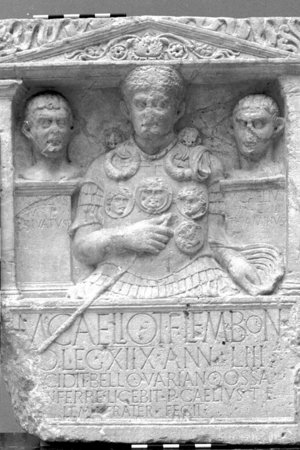 Centurion-Primipil Marcus Caelius tombstone from the 18th Legion, who died in the Teutaburg Forest. It is currently reposited at the museum of «Rheinisches Landesmuseum in Bonn». 1st century CE
Centurion-Primipil Marcus Caelius tombstone from the 18th Legion, who died in the Teutaburg Forest. It is currently reposited at the museum of «Rheinisches Landesmuseum in Bonn». 1st century CE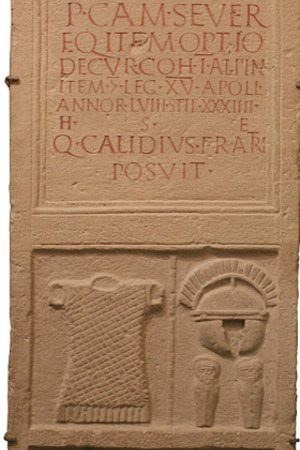 Titus Calidius Severus tombstone stele, a horseman, optio and decurion from the First equestrian cohort of the Alpines, later centurion of the XV "Apollonian" Legion (Legio XV Apollinaris Pia Fidelis). Discovered in 1880 yr. in the ruins of the Roman Carnuntum (Lat. Carnuntum). Is currently reposited in Austria, Vienna in Kunsthistorisches Museum (Museum of fine arts). 1st century CE
Titus Calidius Severus tombstone stele, a horseman, optio and decurion from the First equestrian cohort of the Alpines, later centurion of the XV "Apollonian" Legion (Legio XV Apollinaris Pia Fidelis). Discovered in 1880 yr. in the ruins of the Roman Carnuntum (Lat. Carnuntum). Is currently reposited in Austria, Vienna in Kunsthistorisches Museum (Museum of fine arts). 1st century CE List of centurion’s potential apparel:
1) Civic Crown
2) Armillas
3) Fallers
4) Lorica Squamata, Lorica Hamata, Lorica Musculata
6) Subarmalis
7) Vitis
8) Ocrea
10) Tunic
12) Liner
13) Cingulum
14) Gladius
15) Pugio
16) Focale
17) Socks
18) Subligaculum
19) Fibula
20) Rings
21) Scutum
22) Fascia Ventralis
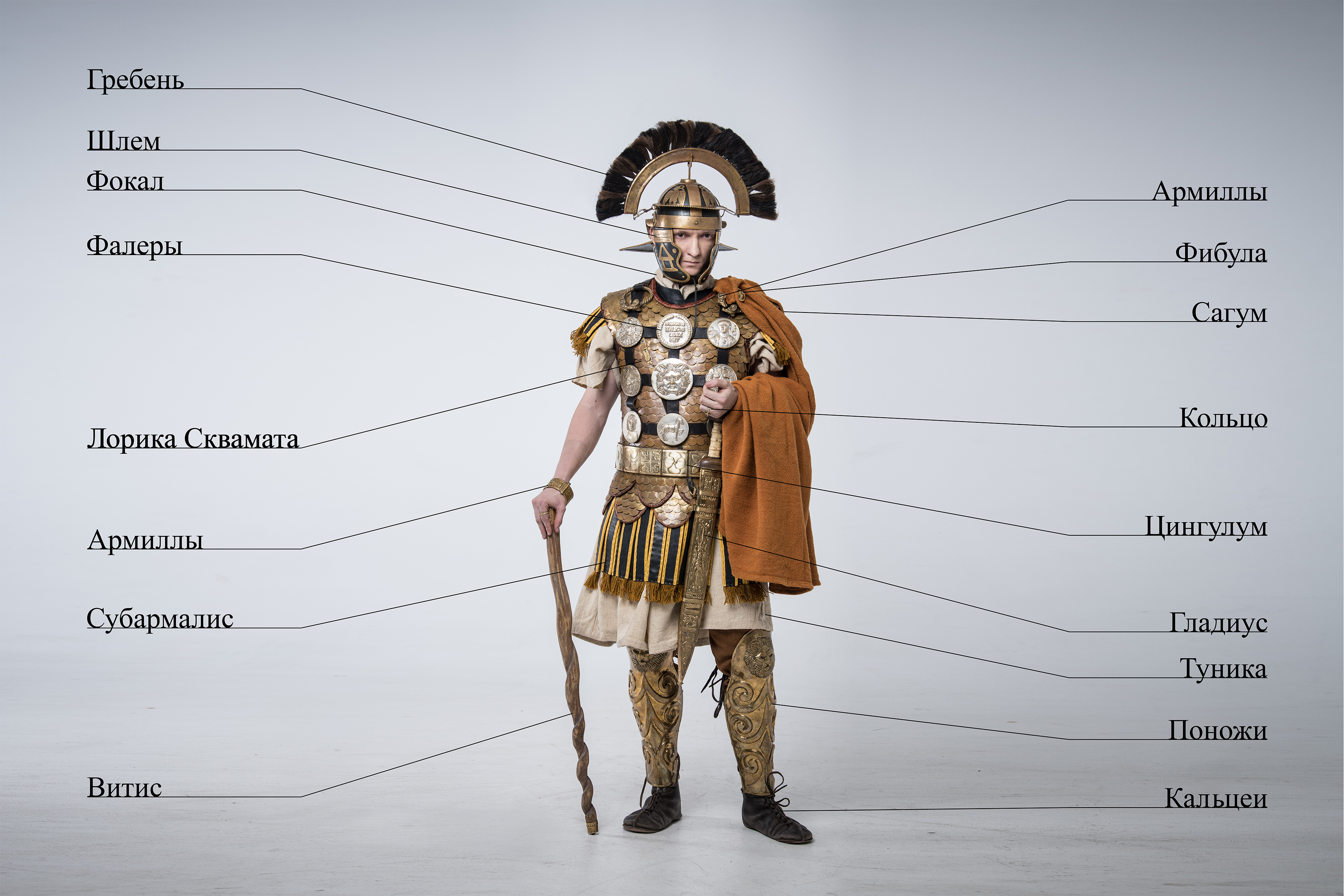
Reenactment
Centurion (particularly his dress coat) – is quite difficult and expensive outfit for reenactment. You can start your centurion dress with a civilian one, basing on centurion’s bas-relief from Padova’s museum. A minimum centurion’s set for reenactment would be similar to a legionary’s one besides two things – vitis and absence of cingulum suspensories. For the further development of the suit, it would be a great idea to aim at making the costume as close as possible to one of the specific bas-reliefs. Centurion can have free different apparels: for battle, civil one and a dress coat.
Related topics
Legion, Legionnaire, Award Wreath, Armillas, Phaleres, Lorica Squamata, Lorica Hamata, Lorica Musculata, Sagum, Penula, Subarmalis, Vitis, Oсrea, Calcei, Сaligi, Tunic, Helmet , Liner, Cingulum, Gladius, Pugio, Focale, Socks, Subligaculum, Fibula, Rings, Scutum, Fascia Ventralis, Crown
Literature
• Caes. De Bell. civ. – Гай Юлий Цезарь. Гражданская война // Записки Юлия Цезаря и его продолжателей. М., 2002.
• CIL. – Corpus inscriptionum Latinarum. Vol. I-XVI. Berolini
• ILS. – Dessau H. Inscriptiones Latinae selectae. Vol. I-III. Berolini, 1892-1914 (2 ed. 1954-1955).
• Jos. Bell. Iud. — Иосиф Флавий. Иудейская война / Пер. Я.Л. Чертка. Минск, 1991.
• Plin. Nat. Hist. — С. Plini Secundi Naturalis historia / Recensuit D. Detlifsen. Vol. IV—V. Berolini, 1871—1873.
• Tac. Hist. — Тацит. История / Пер. Г. С. Кнабе // Там же. Т. П. М., 1993.
• Tac. Ann. — Тацит. Анналы / Пер. А. С. Бобовича // Кор¬нелий Тацит. Сочинения: В 2 т.: Изд. подгот. А. С. Бобович, Я. М. Боровский, М. Е. Сергеенко. Т. I. M., 1993.
• Tertul. De coron. – Творения Тертуллиана, христианского писателя в конце I и начале II в. СПб., 1847.
• Veget. — Флавий Вегеций Ренат. Краткое изложение военного дела / Пер. С. П. Кондратьева // Греческие полиоркетики. Флавий Вегеций Ренат. СПб., 1996.
• Bishop, Coulston, 1993. – Bishop, M.C., Coulston, J.C. Roman Military Equipment from the Punic Wars to the Fall of Rome. London, 1993.
• Connolly, 1981. – Connolly P. Greece and Rome at War. London, 1981.
• Curle, 1911. – Curle J. A Roman Frontier Post and its People. The Fort at Newstead. Glasgow, 1911.
• Hofmann, 1905. – Hofmann A. Römische Militärgrabsteine der Donauländer. Vienna, 1905.
• Jahn, 1860. – Jahn O. Die Lauersforter Phalerae. Fest-Programm zu Winckelmanns Geburtstage. Bonn, 1860.
• Lehner, 1904. – Lehner,H. Die Einzelfunde von Novaesium // Bonner Jahrbücher. 111-12, c. 243-418.
• Maxfield, 1981. – Maxfield V.A. The Military Decorations of the Roman Army. London, 1981.
• Robinson, 1975. – Robinson H.R. The Armour of Imperial Rome. London, 1975.

 Gallery
Gallery






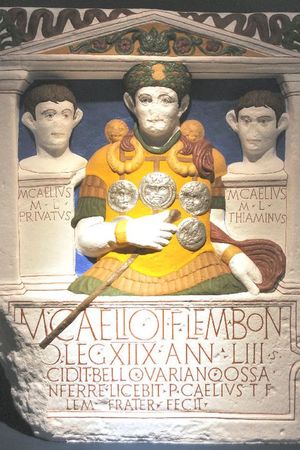 Primipil Marcus Caelius tombstone from the 18th Legion in color. It’s reposited in «Rheinisches Landesmuseum in Bonn». 1st century CE
Primipil Marcus Caelius tombstone from the 18th Legion in color. It’s reposited in «Rheinisches Landesmuseum in Bonn». 1st century CE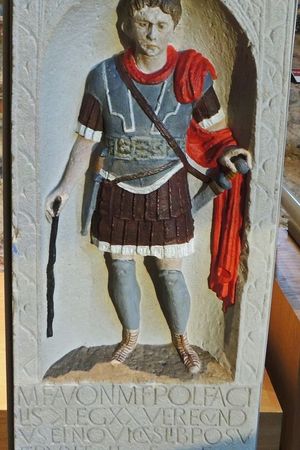 Colored Tombstone of Centurion Marcus Favonius Facilis from the XX (Valeria Victrix) Valerian Victorious Legion. Colchester. Colchester and Essex Museum. 1st century CE (43-50 CE)
Colored Tombstone of Centurion Marcus Favonius Facilis from the XX (Valeria Victrix) Valerian Victorious Legion. Colchester. Colchester and Essex Museum. 1st century CE (43-50 CE)